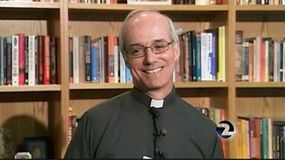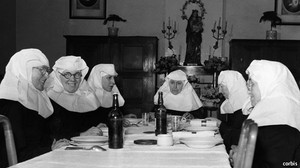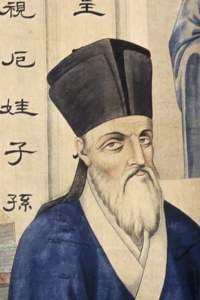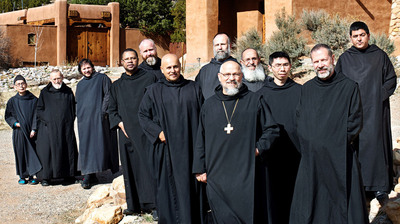 Jesuit Father Alfonso José Gomez met his first Jesuit in 1979 who later turned out to be his religious superior in Argentina; with the passage of time this Jesuit became a bishop, and now pope, Father Jorge Mario Bergoglio (bishop) now Pope Francis. Many of us are still interested to know more about the man who sits in the Chair of Peter. The Indian Jesuit journal Jivan published an interview with Father Gomez conducted by Father John Rose, SJ.
Jesuit Father Alfonso José Gomez met his first Jesuit in 1979 who later turned out to be his religious superior in Argentina; with the passage of time this Jesuit became a bishop, and now pope, Father Jorge Mario Bergoglio (bishop) now Pope Francis. Many of us are still interested to know more about the man who sits in the Chair of Peter. The Indian Jesuit journal Jivan published an interview with Father Gomez conducted by Father John Rose, SJ.
Who were the Beguines?
 The beguines? Indeed, a good question. I have only heard of the beguines in a school a decade ago and thought nothing more of them. The beguines are a group of women who’re not nuns bound by vows, but lived in community and wore a habit. A lay movement from the 12th century. The women who followed the beguine way of life were united in the common life, in prayer, in mission, that is, they had a life of living of the gospel in service of humanity.
The beguines? Indeed, a good question. I have only heard of the beguines in a school a decade ago and thought nothing more of them. The beguines are a group of women who’re not nuns bound by vows, but lived in community and wore a habit. A lay movement from the 12th century. The women who followed the beguine way of life were united in the common life, in prayer, in mission, that is, they had a life of living of the gospel in service of humanity.
Only the Spirit can awaken diversity
Pentecost is a difficult feast for some people. The Holy Spirit is sometimes called forgotten member of the Godhead. It takes a lot of time to understand what it means to live by the Spirit, to be sustained by the Spirit, to be set in motion by the Spirit for the good of all. There is a creative tension with the Holy Spirit: a genuine freedom for something and being in harmony, in unity with all others, even when it rubs me the wrong way. Here, let’s agree that freedom means something along the lines as adhering to what God wants for us, that is, seeking out our destiny. It certainly doesn’t mean licentiousness. As the Pope points out in the paragraph I cited below, the Holy Spirit is awakens in me the reality of unity and not uniformity. And there is the rub for many: how do I live with unity and not get consumed by an ideology of uniformity? Many can’t fathom living with a diversity of belief and practice of the faith. Here I am thinking how the gospel has been inculturated in the East and the West. For example, the rule of law in Eastern Christianity is different on many levels than it is in the Western form of Christianity. When we live parallel lives to that of the Church, or a life that dismisses the diversity of gifts, we can say with confidence that we are not living with the Spirit’s guidance.
…the Holy Spirit would appear to create disorder in the Church, since he brings the diversity of charisms and gifts; yet all this, by his working, is a great source of wealth, for the Holy Spirit is the Spirit of unity, which does not mean uniformity, but which leads everything back to harmony. In the Church, it is the Holy Spirit who creates harmony. One of Fathers of the Church has an expression which I love: the Holy Spirit himself is harmony – “Ipse harmonia est”. Only the Spirit can awaken diversity, plurality and multiplicity, while at the same time building unity. Here too, when we are the ones who try to create diversity and close ourselves up in what makes us different and other, we bring division. When we are the ones who want to build unity in accordance with our human plans, we end up creating uniformity, standardization. But if instead we let ourselve be guided by the Spirit, richness, variety and diversity never become a source of conflict, because he impels us to experience variety within the communion of the Church. Journeying together in the Church, under the guidance of her pastors who possess a special charism and ministry, is a sign of the working of the Holy Spirit. Having a sense of the Church is something fundamental for every Christian, every community and every movement. It is the Church which brings Christ to me, and me to Christ; parallel journeys are dangerous! When we venture beyond (proagon) the Church’s teaching and community, and do not remain in them, we are not one with the God of Jesus Christ (cf. 2 Jn 9). So let us ask ourselves: Am I open to the harmony of the Holy Spirit, overcoming every form of exclusivity? Do I let myself be guided by him, living in the Church and with the Church?
Pope Francis
Homily for Pentecost, excerpt
19 May 2013
The Spirit writes on your heart, and not on tablets of stone
Think of the difference between what happened at Pentecost and what happened at Sinai. There, the people stood at a distance. The mood was one of fear rather than love…Scripture tells us that God came down in the form of fire, and while the people stood in terror at a distance he wrote with his finger on tablets of stone…But when the Holy Spirit came, the believers were all together in one place. Instead of terrifying them by descending on a mountain top, he came into the house. Suddenly there came from heaven a sound like a strong, driving wind. In spite of the noise, no one was afraid…On the mountain there was also smoke, whereas in the upper room there were only clear, steady flames. These came to rest on each one of them, and they began to speak in other tongues…Listen to a person speaking an unknown tongue: it must be evident to you that the Spirit is writing on the heart, and no longer on tablets of stone. So then, it is not on stone, but in your hearts, that the life-giving law of the Spirit has been written. In Christ Jesus, in whom the true Passover has been perfectly celebrated, this law has set you free from the law of sin and death.
Responding to the mystery of the living God as beggars of faith
A person with certitude in someone or something is going to propose that you consider making an inquiry into what is the cause of your certainty and hope. Naturally we will want to share with others and to deepen within ourselves a reality that blossoms as a beautiful new flower. The draw of that flower is no mere superficial thing: there is hope, beauty, expectation, communication, an essentiality that is unique. This is the role of the Pope who gives good example and daily tells us the cause of his joy and hope in being a friend of Jesus Christ. He encourages to look deeper into our faith in Christ and not to settle for less than what has been offered, that is, everything.
“Being Christian is not just obeying orders but means being in Christ, thinking like Him, acting like Him, loving like Him; it means letting Him take possession of our life and change it, transform it and free it from the darkness of evil and sin” (Pope Francis, General Audience, April 10, 2013).
The head of the ecclesial movement, Communion and Liberation, Father Julián Carrón reflects on what it means to be a Christian today with the help of the new pope in L’Osservatore Romano (18 May 2013), in “As Beggars of Faith.” It is a brief reflection on what he sees going on with Pope Francis leading the Church as he meets with the Church’s many ecclesial movements.
The text of Father Carrón’s reflection is here: JCarrón As Beggars of Faith.pdf
Matteo Ricci’s cause for sainthood moves to Rome
 A while ago I mentioned the sainthood study of the 17th century Jesuit Father Matteo Ricci being opened by Diocese of Macerata. The diocesan phase officially closed on May 10th and the findings were sent to the Congregation for Saints at the Holy See.
A while ago I mentioned the sainthood study of the 17th century Jesuit Father Matteo Ricci being opened by Diocese of Macerata. The diocesan phase officially closed on May 10th and the findings were sent to the Congregation for Saints at the Holy See.
What is Benedictine monastic life?
To answer that question let’s turn to the late Dom David Knowles, from Downside Abbey in England, who offered a timeless definition half a century ago. He wrote: “Benedictine monachism presents an objective form of life, sane, strong, unchanging from year to year, a life of work and liturgical prayer which can be seen and heard, lived in conditions which aim at representing all that is best in the basic family life of Christianity, aided by all human courtesies, reverences, and affections. It is nothing secret or esoteric, nor an impossibility, but an ordinary form of ordinary life.” (Benedictine Peace, 49-50)
The Holy Spirit makes us sons and daughters of God
This weekend we are celebrating the Pentecost. The gift of the Holy Spirit was promised by Jesus; the Spirit is what creates and sustains us. In 2006 Pope Benedict met with members of the ecclesial movements. What follows the points he made on the Holy Spirit that I thought would be good to meditate on today. Our study and prayer to and in the Spirit is not well known in the Church so I think this material appropriate for formation and evangelization. As part of the Year of Faith observances the ecclesial movements are meeting with Pope Francis today and tomorrow. Come, Holy Spirit!
The Holy Spirit, in giving life and freedom, also gives unity. These are three gifts that are inseparable from one another. I have already gone on too long; but let me say a brief word about unity.
To understand it, we might find a sentence useful which at first seems rather to distance us from it. Jesus said to Nicodemus, who came to him with his questions by night: “The wind blows where it wills” (Jn 3: 8). But the Spirit’s will is not arbitrary. It is the will of truth and goodness.
Therefore, he does not blow from anywhere, now from one place and then from another; his breath is not wasted but brings us together because the truth unites and love unites.
Continue reading The Holy Spirit makes us sons and daughters of God
Pope Francis helped US Pontifical Mission Societies broaden reach
The Pontifical Mission Societies in the USA are expanding their work of proposing the Good News of Jesus Christ with the help of technology.
This new initiative of the new evangelization come with the help of the boss himself, Pope Francis. He unlocked the new App. Oblate Father Andrew Small assisted. The MISSIO App may be downloaded free wherever Apps are available.
Missionary work need not only be in foreign countries. Missionary work in the United States of America is a real need even today. There are people in the USA, in Connecticut, that have yet to hear and live “Good News” of Jesus Christ and experience the Lord’s great love through the work and witness of the Catholic Church. Can each of us be motivated by the command of Jesus to “go, make disciples of all nations”?
While the Catholic Church in the USA is no longer considered as ‘mission territory’ by the Congregation for the Evangelization of Peoples, that is, we no longer depend on financial support and manpower from other nations, the fact is that we need to continue to propose to one and all that Jesus is The Way, The Truth, and The Life. A possible resource for us in Connecticut is the Propagation of the Faith, “One Family in Mission” (a new web site).
The Church in the USA has four groups help the “least among us” that are known as The Pontifical Mission Societies:
- The Society for the Propagation of the Faith
- The Society of St Peter Apostle
- Missionary Childhood Association
- Missionary Union of Priests and Religious
2013 is the 151st anniversary of the death of the founder of the Society for the Propagation of the Faith, Pauline Marie Jaricot. With the Venerable Servant of God Pauline Jaricot let us contribute to the work of the New Evangelization, be that match that lit the fire of love and service of the Gospel of Jesus Christ.
Saint Simon Stock
Saint Simon was the English Carmelite Superior General of the Carmelite Order (†1265) who is most remembered for receiving from the Blessed Virgin the brown scapular with a promise that one is not lost at death if wearing the scapular. Stock was a hymn writer, a good leader and a man of sanctity, whom the Church recognized soon after his death. The liturgical offices were approved by the Church in the 15th century.
It is said that Simon heard the Mother of God say,
Hoc erit tibi et cunctis Carmelitis privilegium, in hoc habitu moriens salvabitur.
(This shall be the privilege for you and for all the Carmelites, that anyone dying in this habit shall be saved.)
The bestowal of the scapular was given to the Carmelite friars alone but now any priest can bless and enroll someone in the scapular. The brown scapular is associated with the Carmelite friars with the title of Our Lady of Mount Carmel. The brown scapular is one 18 approved scapulars worn in devotion.
There is a lot of pious legend about today’s saint, but there are some things that we are reasonably sure about. The Bollandists write the following of Saint Simon Stock:
Saint Simon Stock was born of one of the most illustrious Christian families of England, at the castle of Harford in 1164. Certain prodigies marked him, while an infant in the cradle, as a soul chosen by the Mother of God for Her own. Not yet one year old, he was heard to say the Angelic Salutation distinctly, before he had reached the age to learn it. As soon as he could read he began to recite the Little Office of the Blessed Virgin, and he would never cease to do so daily. He read Holy Scripture on his knees at the age of six. He became the object of the jealous persecution of one of his brothers, and at the age of twelve determined to leave and go to live in a forest.








